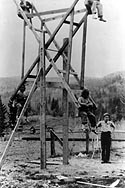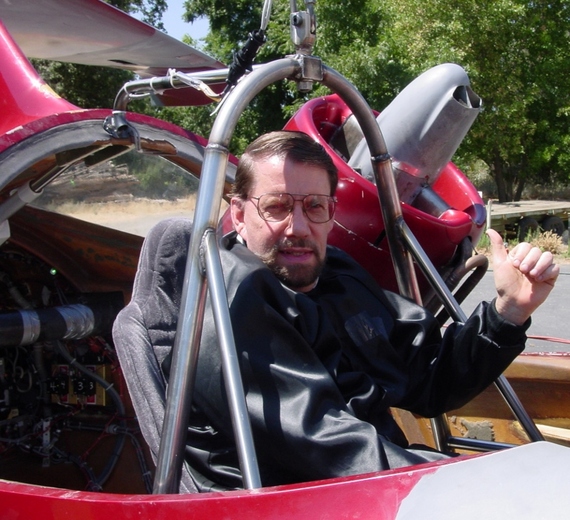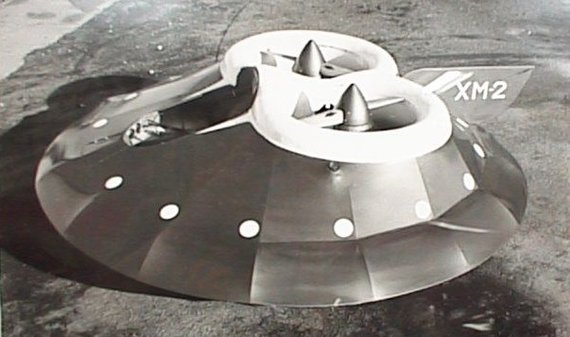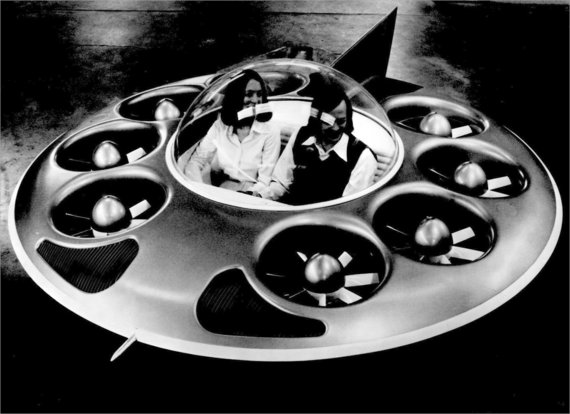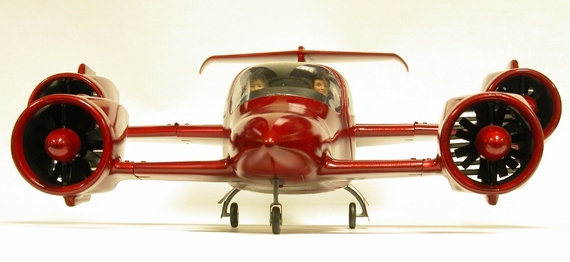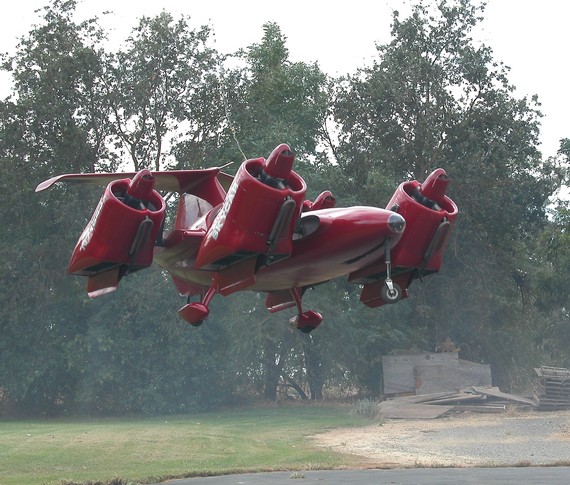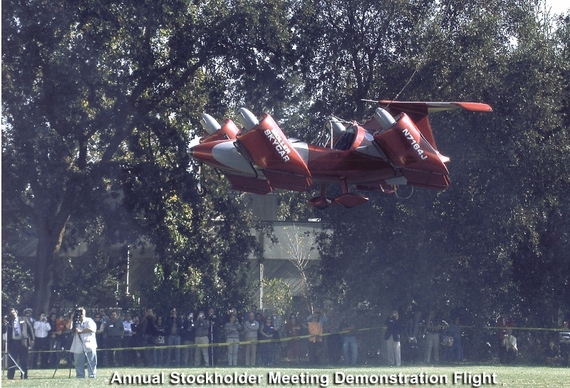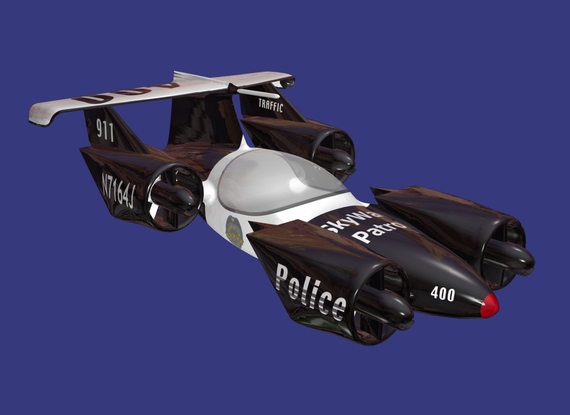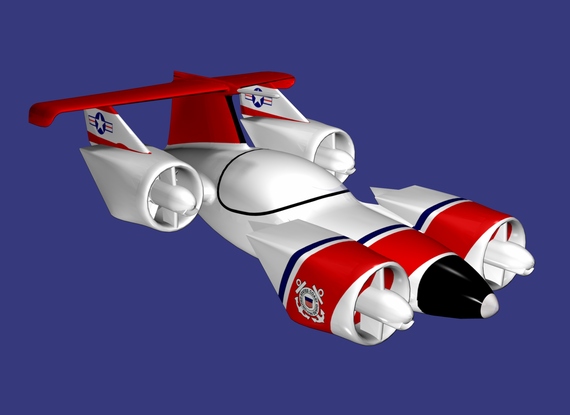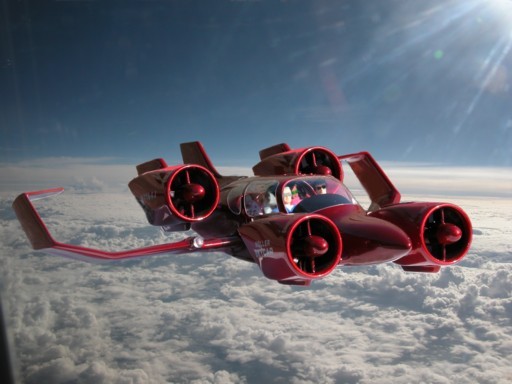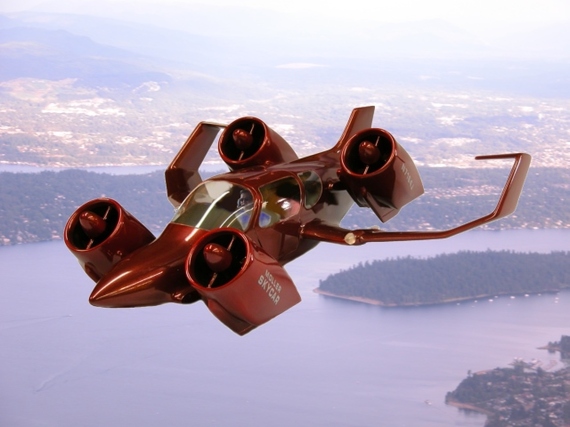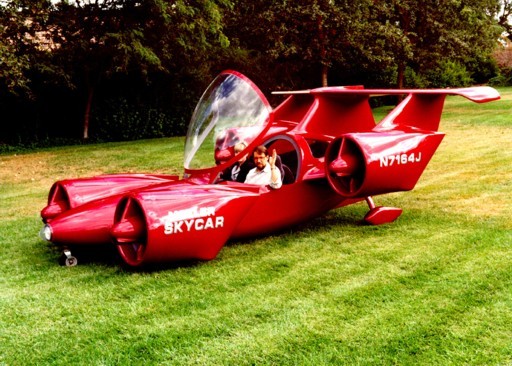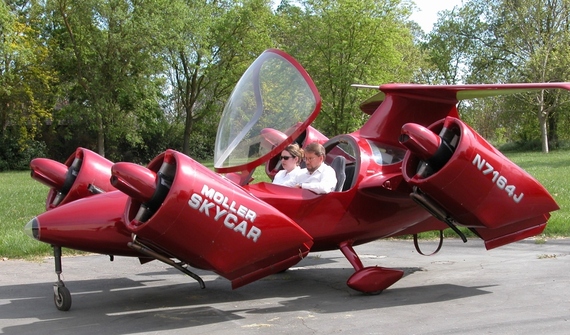
In telling this story, your intrepid reporter Bill Robinson meets Dr. Paul Moller, the inventor of the futuristic Skycar, a VTOL (Vertical Take-Off and Landing) vehicle. The press has written copious colossal criticisms and unflattering articles on the Moller Skycar in the past, however TechFuture thought to be fair, another look was warranted.
"Impossible is a word to be found only in the dictionary of fools." --Napoleon Bonaparte (1769-1821)
"The difference between the impossible and the possible lies in a man's determination." --Tommy Lasorda (1927- )
A long-ago Scientific American article proclaimed:
"The 21st century feels like a letdown. We were promised flying cars, space colonies and 15-hour workweeks. Robots were supposed to do our chores, except when they were organizing rebellions; children were supposed to learn about disease from history books; portable fusion reactors were supposed to be on sale at the Home Depot. Even dystopian visions of the future predicted leaps of technology and social organization that leave our era in the dust."
It's the "flying cars" part that this column will examine.
I don't know about you, but I'm not all that disappointed or "letdown" because I know they are coming; it's just a matter of time.
However, if you are feeling dejected and gloomy, never fear; there's a flying car coming right at you in the near future. A "Jetsons-like" transportation mode is just around the corner.
Steadfastly ignoring all the detractors and naysayers, Dr. Paul Moller has pursued his beautiful obsession to the hilt; never giving a damn about what Scientific American or anybody else was saying. He just kept right on pushing.
Aeronautical and engineering experts have declared Moller's Skycar as "impossible" and online flamers have pontificated for years that it's a fraud, laughing and calling names all the way. But Moller and his company Moller International carry right on, unabated on his 50-year plus journey and quest for a flying car to change human life forever.
I'm with him 1000%. I always support the underdog. I like the 'Davids' of this world and their chances to overcome insurmountable odds. I just love people who pursue their dream and don't let any of the nattering nabobs of negativism get in their way.
None of the people who love to hate Paul Moller have talked to the man. They haven't done extensive research on him, his designs or the evolution of his Skycar; they know nothing and just lie back criticizing. Well here is Paul Moller's story.
Growing up in a very rural part of Canada, Moller says he never really liked school. Being much more manually inclined, after high school he went to a trade school becoming a certified airplane mechanic. This necessitated his learning sheet welding and a whole host of other mechanical trade-oriented skills.
Young Paul liked to build things. He finished his first house at age six and completed the second, this one a two-story job at nine. By the time he reached 11, he'd expanded his interest from simple earthly construction to flight, or better said, things which would take him flying.
He then built a Ferris Wheel which was hand-cranked. No slouch this Moller fellow and the local kids loved the rides too.
Age 15 saw him in a sports car of his own building but even this was not enough as he then tackled building his own helicopter. However, the inherent dangers of the blades and difficulty in piloting a helicopter meant that the never-satisfied Moller had to build another, better type of vehicle.
So how did this mechanic and builder become a Master of Engineering and a Doctor of Aerodynamics?
"McGill University is in Montreal," Dr. Moller began, "and is kind of a Cambridge/Oxford-type institution. I had the great fortuity to meet a great professor there who motivated me to seek further education and allowed me to enroll in his graduate program though I had taken no undergraduate classes at all." It was at McGill that Moller got the aforementioned two graduate degrees with no undergraduate degree and then began teaching at the University of California at Davis (near Sacramento) where he set-up the Aeronautical Engineering program. He is one of the very few people to get these advanced degress without obtaining an undergraduate degree first.
About the move from freezing Montreal to sunny California, Moller quite naturally but emphatically says, "I couldn't take one more cold winter."
The moment of truth for Moller that led to his half-century crusade to produce the world's first flying car happened interestingly enough when he was five years old.
Trying to get to school through feet and feet of snow in British Columbia was the spark which ignited the search for a different form of transport within Moller's mind. According to Moller, "a humming bird was the inspiration." At the time, there were no jet planes or helicopters yet and Moller was really testing the limits of gravity with his thread-pulling type of thinking.
"My father was a chicken-farmer," he said giving hope to chicken-farmer' children everywhere, "and I rescued a hummingbird from my father's shed. When I opened the door, he flew out, hovered for about 30 seconds and then flew away at a high rate of speed."
This, believe it or not, was the one instant where Moller started his cause.
Hummingbirds flap their wings at the same rate of speed whether hovering or in directional flight--about 80 times per second. Using this aerodynamic principle as the model, Moller began pursuing the same type of flying research which has yielded the Harrier "Jump Jet."
A vehicle which could take-off from even a small area such as a driveway, Moller reasoned, then use the same propulsion source to move directionally, would be the most useful especially for broad consumer use.
"I suppose you could say it started with my first helicopter design in 1951 (partly built before I realized that I did not have the tools or skills to finish it). The next effort was in 1962 when I built the first powered scale model of the XM-2. The Skycar model building and wind tunnel testing began in the late 1980's after the Neuera 200 was demonstrated before the press."
"The rotary engine is the essence of the Skycar," Moller pointed out excitedly, "when you think about it, the rotary engine is not very different from a hummingbird in that it has a very high metabolism rate. Felix Wankel (inventor of the rotary engine which bears his name) was a genius. We took his principles and because our engines needed to operate efficiently at a higher power, we made some basic changes."
Whereas Mazda, one of the few car brands to employ these rotary devices uses water to cool their automobile engines, Moller Corporation the company the Dr. Moller founded in 1983, uses air as a coolant.
During Moller's childhood, adolescence and adulthood he had pursued this dream doggedly. Even while he was attending class, teaching or working on other businesses, his mind never wandered far from the ultimate goal: a skycar.
In 1962, he built a six-to-one scale model of what he called the XM-2 and two years later completed a full-size prototype in his Davis, California garage. What follows here, are to me, real "Flash Gordon" type Flying Saucers.
Moller's XM-2 also has caused a bit of a false UFO phenomenon over the years with this early footage on YouTube.
Models XM-3 and XM-4 followed in 1968 as Moller refined the mechanics of his "beautiful machine."
Many hurdles were encountered along the way but perhaps none more important than the engine technology; how was this contraption going to be propelled?
It wasn't until 1985 that Dr. Moller had a stupendous opportunity to ensure the future of the Skycar, which he grabbed with both hands and refused to let go. In what was called "the single most important development" for the Skycar, Moller acquired the rights to Outboard Marine Corporation's (OMC, the makers of the old "Johnson" and "Evinrude" outboard boat motors) Wankel-type motors. Moller has since set-up Freedom Motors which manufactures the Skycar engines as a separate entity.
"This was the real beginning of the Skycar," Moller proudly stated like a father looking through the maternity ward window. "However, there is no financial assistance for emerging technologies out there," he said dismally, "if you want to get money for something like I'm doing, I don't know where you can get it." Though I must say "the couple of hundred million" Dr. Moller's raised over the years isn't a bad start.
Wouldn't the auto makers be a great source for strategic investment? After all, they'd have to be interested in protecting their business and hedging their bets simultaneously. "GM is a copier," Moller started and I knew this was going to be good, "and they don't even copy well. They're in terrible financial condition-basically bankrupt and they're doing nothing new." Apparently, I touched a nerve left raw and exposed by multiple approaches to the car companies.
Not long thereafter after acquiring OMC's engine capabilities, Dr. Moller brought out the X150 Skycar.
Today, Moller is betting the farm on the M400 Skycar which he says is the one for world domination.
Passengers: 4
Top speed @ 25,000 ft: 350 mph
Cruise speed @ 25,000 ft (80% Max Range): 315 mph
Cruise speed @ 25,000 ft (Max Range): 205 mph
Cruise speed @ Sea Level (Max Range): 140 mph
Maximum rate of climb: 3800 fpm
Maximum range: 750 miles
Net payload: 750 lbs
Fuel consumption: approx. 20 mpg
Operational ceiling: 32,000 ft
Gross weight: 2400 lbs
Installed engine power: 865 hp
Power boost (emergency): 33%
Dimensions (LxWxH): 21.5' x 8.5' x 7.5'
Takeoff and landing area: 35 ft dia
Noise level at 500 ft: 65 dba (Goal)
Vertical takeoff and landing: yes
Uses automotive gas: yes
Emergency parachutes: yes
Dr. Moller has flown the M400 "a couple of dozen times, very low to the ground" about 40-feet up and a few hundred feet in every direction. He says he's "getting to the point where I'd be comfortable flying four passengers and their cargo around for a longer period." In spite of Dr. Moller's status as the leading, if not only, Skycar scientist there are still strict limits on how far, high and fast he can go in his invention.
It is the "vertical take-off and landing" part of the Skycar which really makes it unique and exciting. Otherwise, it's just an airplane.
A lot of late nights and deep thought has gone into this vision and Moller must've been pulling his hair out at times. "As you may know the average car carries 1.3 people per trip," Moller told me. "Despite this, most cars are designed to carry four to five people because the cost for a two-passenger vs. five-passenger vehicle is about the same. Smaller two-passenger cars scare people because the consequences of a collision with a larger vehicle are substantial."
Moller continued with some more technical speak, "This is very different for an aircraft, particularly one that can take-off and land vertically. The problem is that lifting thrust is not directly related to power. Instead thrust is related to power (thrust is proportional to hp2/3). This means the Skycar requires twice the power to lift approximately 50% more weight. This also means that the four-passenger Skycar 400 is going to cost substantially more than the Skycar 200. On the other hand, there is no increased danger in operating a one-passenger Skycar 100 versus a six-passenger Skycar 600."
"The Skycar 200 and Skycar 400 have much in common with the M400 Skycar in terms of propulsion, flight control system and general appearance however with 10 years of additional wind-tunnel work and engines with much greater power there are some significant differences which we have not exposed to the public due to patents in an 'applied for' stage. We call all of our vehicles 'volantors' as from 'volant' meaning capable of flying in a light, nimble manner. The Firefly is the rescue version of the Neuera 200."
"Skycar would be used in most cases as a rental vehicle or as an 'on-demand' air taxi then the Skycar would and should be available for rent in all sizes from one to six passengers," Moller envisions. The Skycar appears to be able to approach 100 passenger miles per gallon independent of size and achieve more than twice the actual passenger miles per gallon of today's automobile."
"This is a long-winded way of saying that I think the Skycar 200 will dominate the user market as a rental vehicle while, the Skycar 600 would be the ideal air taxi."
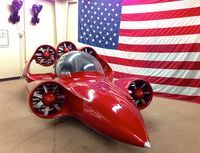
The Skycar 200LS which Moller predicts will dominate the rental car market
Photo Credit: Eric Molinsky
"We are working with the FAA to get a powered lift sub-category established within the 'Light Sport Aircraft' category. This would greatly reduce the cost of owning and operating a 'light powered lift' aircraft."
Moller does have stockholders, investors and buyers who, much like the first Teslas, queued up for a first crack at Skycar ownership. But the critical mass necessary to turn his Skycar into a massive consumer phenomenon like the Internet has not come to fruition.
Just as Scientific American imagined, is Dr. Moller disappointed that his Skycar hasn't yet taken off? "Well, yes and no," Moller observed, "Of course I wanted it to be in wide use by today, but without that virtual highway in the sky--the Small Aircraft Transportation System (SATS)--a free-flight system laying out all the rules, it's simply impossible."
Couldn't he just cruise around in his design since he's the only one with such a vehicle? "Unlikely," he responded. Seems there are all kinds of commercial and civilian regulatory authorities who would pummel him if he did.
Imagine Moller heading off for an appointment for which he's late, really moving quite fast (there are no speed-limits up there yet) and he hears a bullhorn from behind sternly command, "Pull that VTOL over and hover!"
Or Moller, decides to bring a little contraband into the States through the Mexican border with California, only to see one of these bearing down on him. (Not that he ever would of course. Remember we're using our imaginations here.)
In 2001, a year before Moller International (OTC-QB Symbol: MLER) went public in an IPO, Dr. Moller attracted the unfortunate attention of an SEC attorney he calls "Mr. X." As the story is told, this attorney got it into his tiny brain that a flying car was impossible, and subsequently believed Moller and the company were defrauding their investors. A multi-year witch hunt ensured during which the stock of Moller's hard-fought company lost 95% of its value.
In a seemingly fine example of good karma, Moller fought back and he wasn't without help. His shareholders stood with him and fired back at the SEC. They created an organization and webpage called SOMI (Shareholders of Moller International) and spoke their truths to power. In 2009, Moller was forced into a personal Chapter 11 bankruptcy reorganization and the plan was approved in 2012. However, the Moller crusade continued undeterred except by a mountain of government agencies and bureaucrats swathing him in red tape. Moller would not give up.
The hovering visionary told me, "One of my favorite maxims which has three parts, is:
Any radically new technology goes through three stages,
1) It is ridiculed by those ignorant of its potential.
And this is the one that gives me the most grief,
2) It is subverted by those threatened by its potential.
3) It is considered self-evident."
Moller's list above reminded me of the late Sir Arthur C. Clarke's "Three Laws." (I interviewed Clarke in Sri Lanka in the early 2000's.)
1. When a distinguished but elderly scientist states that something is possible, he is almost certainly right. When he states that something is impossible, he is very probably wrong.
2. The only way of discovering the limits of the possible is to venture a little way past them into the impossible.
3. Any sufficiently advanced technology is indistinguishable from magic.
Many people have scoffed and sneered at Moller and his Skycar vision in the past, asserting anything from general absurdity to outright deception about Moller and his hard-fought plans. To this he doesn't have a response. Odd I thought, I would certainly reply to my ferocious detractors. I guess people in general today are spring-loaded to the negative side and probably not without reason after the scams we've witnessed but I have noticed that these same people never take into account the longevity of the scientific pursuits and rarely seem to be pursuing their dreams with the same vigor and heartiness Paul Moller pursues his.
Take one aggressive Moller-detractor: R. John Hansman, who is Professor of Aeronautics and Astronautics at MIT and heads up two rather ostentatious-sounding areas called the "Division of Humans and Automation" and the "International Center for Air Transportation." Hansman called Moller's Skycar "a piece of junk," and gave a rather caustic and unfunny comedic representation that such a product already exists " ... it's called a 'helicopter,'" he wise-cracked previously--though I'm hard-pressed to find any non-academic accomplishments on the part of Hansman at all. Seems Hansman is excellent at writing technical papers which are never commercialized and criticizing others out in the business world who are at least giving it a go. While he does hold "6 US patents;" this pales in comparison to Moller's circa 50 patents issued--that's right, 50. Hansman's lack of commercial experience would seem a resounding validation of the old saying, "Those who can, do; those who can't, teach."
When reached at his MIT office, Hansman easily discussed Moller and his invention. "The idea of a Skycar has been around a long time," Hansman said, without saying precisely how long. "If it was such a good idea, wouldn't they be out flying?" he posited cagily. I resisted pointing out that Moller HAD been out flying his Skycar. "I've never seen one which represented a good compromise between a car and an airplane," he said not knowing my next question. "You've seen Moller's Skycar, haven't you?" I said. "No, I haven't personally," was the halting response. Hansman hasn't studied Moller's designs or looked at the specific engineering involved much less been out to Moller's California labs where tours are conducted the third Thursday of every month.
I was speechless. But after a while I mustered up the energy to ask, "How then, did you become one of the most well-known detractors of Dr. Moller?" He said, "The previous comments I made were because a guy like you, a journalist (To which I say, perhaps a journalist--but certainly not a guy "like me") called me up and pulled them out of me." I wasn't surprised that a journo had solicited the comments out of Hansman, what did surprise me was how quickly he caved. "I don't have a vendetta against Dr. Moller or anything," Dr. Hansman stated sounding worried. "So," I enquired, "you'd like to go for a ride in the Skycar someday?" "Of course," Hansman replied, "I'd love to go out to Moller's for a visit."
Dr. Moller "would be pleased to have Professor Hansman out to show him around and discuss the Skycar with him," Moller told me after the Hansman' conversation.
When told of Professor Hansman's interest in visiting for a quick look-see at Skycar, Moller is happy. "This guy's been my biggest detractor," he says merrily.
All disagreements quelled, all arguments mollified; TechScape is glad to be of service.
This is the time when I finally cajole some other responses from Paul Moller to support his dream. He gives me many supportive quotes from others, among them:
Henry Lahore, Project leader of an extensive Skycar study undertaken by Boeing Aircraft Company--"With the developing airspace infrastructure in place, the Skycar will become a widely used un-piloted air-taxi. This is the only known commuter vehicle that can move large numbers of people very quickly and safely and still let them conveniently choose their departure point, departure time and destination."
The late J.B. Nichols, Boeing Aeronautical Systems Consultant to Henry Lahore: "Our estimate of Moller's Skycar performance employing these engine pods corroborates Moller's performance estimates."
Dr. Dennis Bushnell, Chief Scientist, NASA Langley Research Center: "The Volantor (Skycar) will do for car-based society what the car did for horse-based society. It is the right solution at the right time." He goes on to add, "It is not a question of if but when the market for Moller' vehicles will be about $1 trillion a year."
John Vostrez, Chief, Technical and Research Division, California Dept. of Transportation: "Moller's work goes far beyond the technology we're working on. It makes the technology we're working on look fairly mundane." Vostrez says, "Moller's idea is to use the third dimension in a three-dimensional space as opposed to just two dimensional space that we're tied to on the ground. It's really exciting."
ABC-TV, World News Tonight, Peter Jennings: "A remarkable invention that could someday radically change the way we get to work. Definitely a technology on the cutting edge; a personal flying machine."
Smithsonian Institution, INVENTION Series, "The Flying Car," Produced by the Discovery Channel: "Paul Moller is unique in this world of complex high technology. He is an independent entrepreneur who still makes his own test flights. It is the people with imagination and the ability to see past the end of their nose that are going to be the ones flying instead of sitting down here in grid-lock on the freeway."
The Learning Channel (TLC), "The Ultimate Ten Machines Ever Built": A program devoted to describing and rating the ten most significant machines ever built. The Skycar was rated number 6.
People Magazine, Inventors Section, "Flier Paul Moller is a Former Alien With a Real Flying Saucer": "Wary as any test pilot taking up an experimental craft, the man in the fireproof blue suit kissed his wife before climbing into the cockpit. One by one he started the eight rotary engines, then pushed a small red throttle with his left-hand and a joystick with his right. With that, engines whining, the flying saucer rose 40 feet into the air. He took his Volantor on a 150-second spin in Davis."
Henry Ford, Chairman, Ford Motor Company-1940: "Mark my words: A combination airplane and motorcar is coming. You may smile. But it will come."
---------------------------------------------------------------------------------------------
I don't know about you, but I certainly wouldn't bet against Henry Ford. (Who interestingly, declared bankruptcy at least twice before starting Ford Motor Company.)
As the quotes above very clearly show, there is a burgeoning crew of people who think a flying car IS NOT "impossible." And the cast of characters supporting Moller and Skycar is growing; fast.
So Dr. Moller has finally stood up for himself. I admire the fact that he hasn't mounted an all-out war against his enemies, just sat back and waited for their own implosion of negativity.
When will we really see the Skycar proliferate?
"You'll see them in a military or paramilitary application first. The Chinese were very interested in incorporating the Skycar into their defenses," Moller said. We'll see it proliferate "within the next few years" according to the creator. Won't the US government prevent the technology's transfer to China? "No, I don't think so," he predicted, "but I do hope it's American usage first. The war in Iraq provided an interesting opportunity for the Skycar, in terms of unmanned vehicles, though."
"Remember what happened to the Wright Brothers: the US government didn't take any interest in what they were doing, so they came to Europe, became famous over there and were so pissed at the American government that they didn't even bring their plane back to the States until 1944--they kept it in a warehouse across the Atlantic!"
Meanwhile, Moller was approached long ago by the Chinese for their military usage. The American government had better wake-up and smell the Skycar. How ironic would it be, to have billions of Chinese Communists hovering over our capitalistic continents? What would our President think; how would the Pentagon react?
Isn't is possible we might see Bill Gates, George Clooney or Madonna driving one of these things before the government/military buys into them?
Moller's voice lit up, "Well, we've been featured on Tech TV and in a number of Paul Allen-owned media, but never been able to get to the man. We can never get a chance to get in front of him and I honestly feel he would invest in the Skycar if only we could get his attention."
Hear that Paul Allen? It does sound like one of your sort of investments.
With regard to other possible celebrity endorsers, Moller says, "Around 1992, Michael Jackson called up to buy one. He was very popular then and my first thought was, 'what if my Skycar kills Michael Jackson!!?'"
So as Moller flies off into the sunset ... all we can do is wait and wonder when we might all be doing the same.
"There is nothing impossible to him who will try." --Alexander the Great (356BC-323BC)


